Research proposals are nerve-racking, notoriously challenging to write, and can skyrocket your academic career. Does that sound frightening? You bet! This blog will assist you in writing an effective survey research proposal.
The biggest challenge of actualizing a well-thought-out survey research proposal is “no funding.”
How will you persuade decision-makers to fund your research? Your quick answer: A survey research proposal template. The problem is…
You cannot just write a proposal; it must be flawless, especially now that the world has reopened and thousands of talented researchers are competing for positions.
How do you craft a proposal to help you outperform the competition? Spend 10 minutes reading this blog, and you'll know how to do it.
Before we sprint to the heart of the subject, let's establish some basics.
What is a Research Proposal?
A research proposal is a formal educational document. It outlines your research project and requests funding or agreement to supervise your project.
The primary goal of a research proposal is to explain what you intend to study and why it is worth looking into. Most research proposals are used in academia or by non-academic scientific organizations.
Of course, no two research proposals are the same, and they can vary greatly depending on your study level, field, or project specifics.
Still, there are certain general requirements that all significant proposals must meet, and the format that is non-negotiable.
Alright, we finished the theoretical part. It's time to get some practice!
Here's How to Write a Survey Research Proposal With Templates
1. Write an Introduction to Present the Subject of Your Research
"Wow, I cannot wait to see how this study turns out!"
This is the type of response you want for your research proposal introduction.
How can that be accomplished? Structure your research proposal introduction around the following four key issues:
- What is the research question?
- Who is this issue important to (the general public, fellow researchers, specialized professionals, etc.)?
- What is currently known about the problem, and what key pieces of information are missing?
- Why should anyone be concerned about the outcomes?
The simplest way to write an engaging introduction to a research proposal is to use our pre-designed PPT Template.
Sample Survey Research Proposal Template
2. Explain the Context and Background
This section is optional, depending on how detailed your proposal is. It is usually added if the research problem at hand is complex. It is titled "Background and Importance" or "Rationale."
The introduction will include most of the factual background for shorter proposals.
How do you write the "Background" section of a research proposal?
- Describe the broader research area in which your project fits.
- Emphasize the gaps in existing studies and explain why they must be filled.
- Demonstrate how your research will add to existing knowledge.
- Explain your hypothesis and its rationale.
- Determine the scope of your research (in other words, explain what the research is not about).
- Finally, showcase the significance of your research and the benefits it can provide. In other words, respond to the dreaded "So what?" question.
If your research project is technical and complex, describing the background in a separate section is especially beneficial. It makes your introduction follow a free-flowing, "significant" narrative while letting the "Background" section do the heavy lifting.
If you encounter profound scientific discoveries while conducting your research, you’ll need additional help highlighting them. Here are the top 25 scientific PPT Templates to present your new findings.
Sample Survey Research Proposal Template
3. Provide a Detailed Literature Review
The most critical (and the most challenging) section of the entire document is tackled here.
One in which you must demonstrate that you know everything there is to know about your subject of interest and that your research will help advance the entire field of study.
The section on Literature Review is essentially a mini-dissertation. It must follow a logical progression and present the case for your study about previous research: Explain and summarize what has already been discussed, and show that your research goes beyond that.
If there are some statistics you want to highlight here, you’ll need these 25 ways to show statistics in a presentation.
It may be difficult to discuss all the existing research on your subject in the Literature Review. In today's digital age of easy access to information, be selective about which studies or papers you include.
The difficult part? DONE. (No, it truly is.) Everything that follows is a matter of formalities and technicalities. If they're already sold onto your vision, you must show them how you intend to accomplish your goals.
Sample Survey Research Proposal Template
4. List Your Key Aims and Objectives
This section is called "Research Questions" or "Aims and Objectives." It should be brief compared to the previous slides.
The formal requirements of the institution you're applying to dictate:
- Whether you need to write about your goals and objectives, or
- Formulate them as research questions.
The key to mastering this section is distinguishing between an aim, an objective, and a research question.
Here's another practical example to help you understand.
Sample Survey Research Proposal Template
5. Outline the Research Methods and Design
The funding authorities already know what you're attempting to accomplish and have a general idea of how you intend to deliver results. This section demonstrates that you are adequately prepared (in terms of both skills and resources) to conduct the research.
The principal goal is to persuade the reader that your methods are suitable and appropriate for the specific topic.
Do you know why "specific" is in bold? It is one of the parts of a research proposal that varies the most between documents. There is an ideal methodology for every academic project, and no two research designs are alike. Check that your methodology corresponds to all of your desired outcomes.
After all, you know your project better than anyone else. You'll have to make a decision about which methods are best.
You can support your bet with an effective fact sheet you can build using these top 15 PPT Templates.
Here’s a sample template for you.
Sample Survey Research Proposal Template
6. Discuss Ethical Considerations
No, this is not an optional step. If you're researching the vector shapes of tree leaf shadows (yes, it's a legitimate research topic), there won't be many ethical issues to consider.
However, if your research involves humans, particularly in fields such as medicine or psychology, ethical issues are bound to arise.
You must take extra precautions to protect your participants' rights, obtain their explicit consent to process data, and consult the research project with the authorities of your academic institution. For this purpose, your proposal must include detailed information on these topics.
Sample Survey Research Proposal Template
7. Present Preliminary or Desired Implications and Contribution to Knowledge
It is the final argument in your proposal to persuade decision-makers to support your project. You've already stated what the scope of your project will be. You have described the current state of knowledge and highlighted the most significant gaps. You have told them what you want to learn and how you intend to do it.
Now, discuss the actual, measurable difference your discovery can make and how your research can impact the future of the field or even a specific niche.
Sample Survey Research Proposal Template
8. Detail Your Budget and Funding Requirements
If you already have a supervisor (s), you should discuss this section with them. They've most likely submitted similar documents to the institution you're contacting. They can also provide insights into how much you can realistically expect to be paid.
Note: If possible, leave yourself some wiggle room and request a conditional extra allowance.
Sample Survey Research Proposal Template
9. Provide a Timetable
Detailing a timeline in a proposal for a standalone project can help support your budget. The most common format is, as you might expect, a table. Divide your research into stages, list the actions you'll need to take at each stage in bullet points, and set tentative deadlines.
It prevents you from derailing your project.
We have an editable TOC template you can use to define your timetable.
Sample Survey Research Proposal Template
10. End with a List of Citations
Citations in research proposals can take the form of references (which include only the pieces of literature you cited) or a bibliography (everything that you consulted for your proposal).
Double-check with them or consult your supervisor on the format.
The same is true for referencing style. Most universities in the United States use APA or Chicago Style, but each has its own set of rules and preferences. Check the list of guidelines on their website for confirmation. When in doubt, contact the head of the department with which you want to work.
Here’s an editable template you can use to include citations.
Sample Survey Research Proposal Template
FAQs on Survey Research Proposal
What is an example of survey research?
Assume a researcher wants to learn about teenagers' eating habits. In that case, they will follow a group of teenagers for an extended period to ensure that the data gathered is reliable. A longitudinal study is frequently followed by cross-sectional survey research.
In a longitudinal study, researchers examine the same individuals repeatedly to detect any changes that may occur over time. Longitudinal studies are essentially correlational research in which researchers observe and collect data on several variables without attempting to influence them.
A cross-sectional study is a type of research design where data is collected from many people at once. In cross-sectional research, variables are observed without being influenced.
What should a survey proposal include?
The proposal should present your research methodology, with specific examples demonstrating how you will conduct your research (e.g., techniques, sample size, target populations, equipment, data analysis, etc.). Your methods could include going to specific libraries or archives, fieldwork, or conducting interviews.
What are the three types of survey research?
Most research can be classified into three types: exploratory, descriptive, and causal. Each serves a distinct purpose and can only be used in specific ways.
Exploratory Research
Any marketing or business strategy should include exploratory research. Its emphasis is on the discovery of ideas and insights rather than the collection of statistically accurate data. As a result, exploratory research is best suited as the first step in your overall research plan. It is most commonly used to define company issues, potential growth areas, alternative courses of action, and prioritizing areas that require statistical research.
Descriptive Research
Descriptive research accounts for most online surveying and is considered conclusive due to its quantitative nature. In contrast to exploratory research, descriptive research is planned and structured for the information gathered to be statistically inferred from a population.
Causal Research
Causal research, like descriptive research, is quantitative, preplanned, and structured in design. As a result, it is also regarded as conclusive research. Causal research differs from other types of research in that it attempts to explain the cause-and-effect relationship between variables. It differs from descriptive research's observational style in that it uses experimentation to determine whether a relationship is causal.
What is the aim of survey research?
Historically, survey research has included large amounts of population-based data collection. The primary goal of this type of survey research was to quickly obtain information describing the features of a large sample of individuals of interest.
Over To You
Writing a research proposal can be difficult and time-consuming, and it's not that different from writing a thesis or dissertation.
Yes, this is our roundabout way of saying: Don't give up. Invest adequate time to complete your presentation using our actionable survey research proposal templates. When in doubt, reach out to senior researchers for assistance.





 Customer Reviews
Customer Reviews


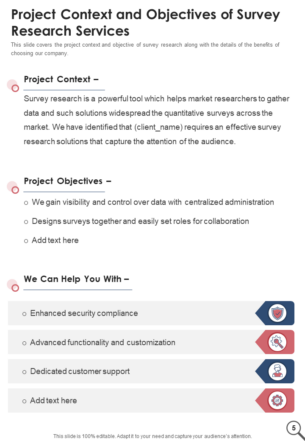
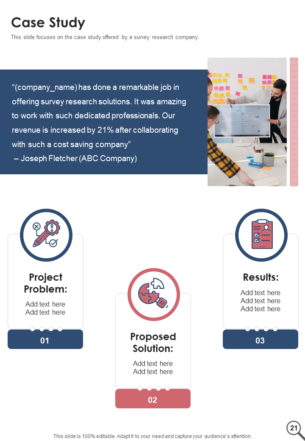
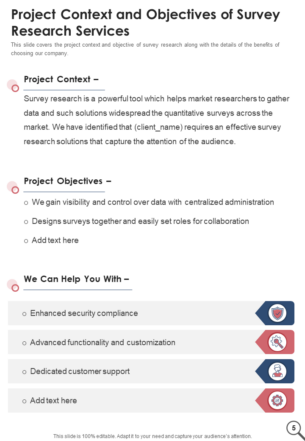
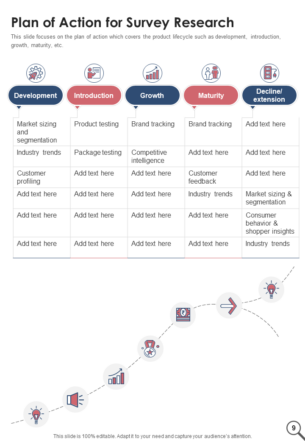
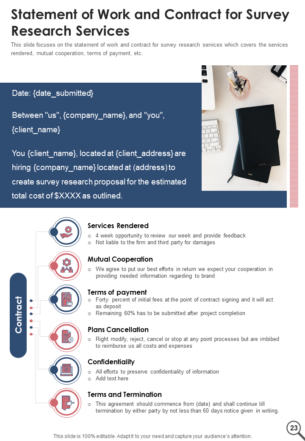
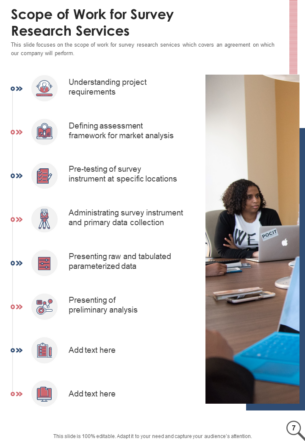
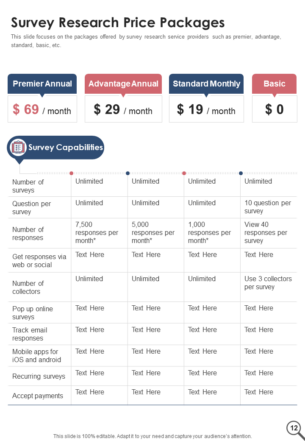
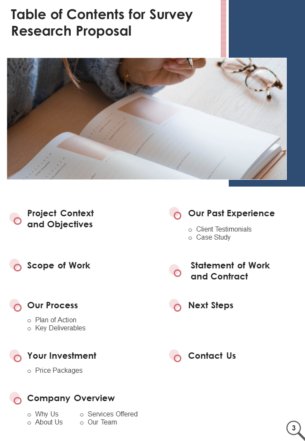
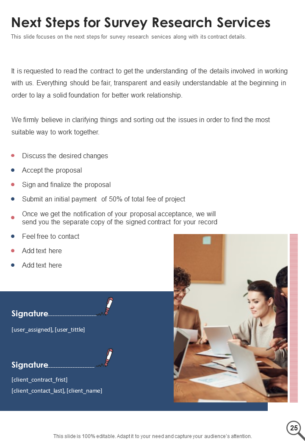
















I want to ask for your permission to show it in my classroom in the course of research methodology in special education.
Pawinee Srisukvatananan